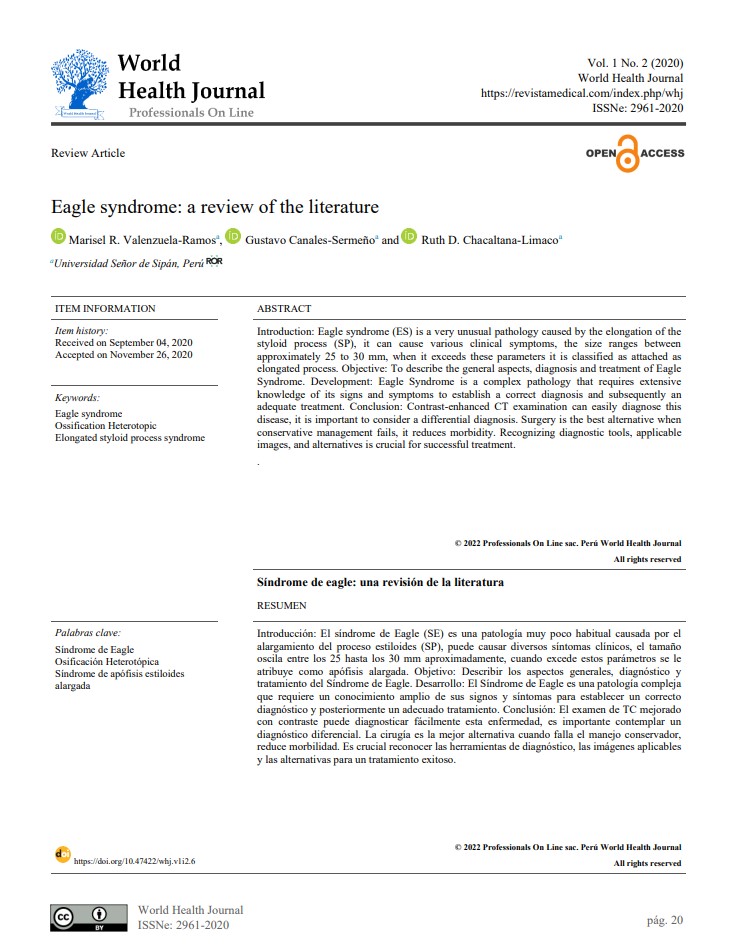Abstract
Introduction: Eagle syndrome (ES) is a very unusual pathology caused by the elongation of the styloid process (SP), it can cause various clinical symptoms, the size ranges between approximately 25 to 30 mm, when it exceeds these parameters it is classified as attached as elongated process. Objective: To describe the general aspects, diagnosis and treatment of Eagle Syndrome. Development: Eagle Syndrome is a complex pathology that requires extensive knowledge of its signs and symptoms to establish a correct diagnosis and subsequently an adequate treatment. Conclusion: Contrast-enhanced CT examination can easily diagnose this disease, it is important to consider a differential diagnosis. Surgery is the best alternative when conservative management fails, it reduces morbidity. Recognizing diagnostic tools, applicable images, and alternatives is crucial for successful treatment.
References
Goomany A, Shayah A, Adams B, Coatesworth A. Eagle syndrome: elongated stylohyoid-associated facial pain. BMJ Case Rep. 24 de marzo de 2020;13(3):e234024.
Pace A, Rossetti V, Iannella G, Magliulo G. Unusual Symptomatology in Eagle Syndrome. Clin Med Insights Case Rep. 2020;13:1179547620948728.
Michiels TD, Marsman MS, van Veen A, Vriens PWHE, Lauret GJ, Heyligers JMM. Eagle Syndrome: A Unique Cause of Carotid Bleeding. JACC Case Rep. marzo de 2020;2(3):449-53.
Czako L, Simko K, Thurzo A, Galis B, Varga I. The Syndrome of Elongated Styloid Process, the Eagle’s Syndrome—From Anatomical, Evolutionary and Embryological Backgrounds to 3D Printing and Personalized Surgery Planning. Report of Five Cases. Medicina (Mex). septiembre de 2020;56(9):458.
Aoun G, Srour N, El-Outa A, Nasseh I. Styloid process elongation in a sample of Lebanese population: a consideration for the prevention of Eagle syndrome. Med Pharm Rep. octubre de 2020;93(4):410-5.
Mahmoud NR, Ashour EM. Cervico-facial pain associated with Eagle’s syndrome misdiagnosed as cranio-mandibular disorders. A retrospective study. J Cranio-Maxillo-fac Surg Off Publ Eur Assoc Cranio-Maxillo-fac Surg. octubre de 2020;48(10):1009-17.
Menichini ML, Marini J, Menichini R. La apófisis estiloides elongada: Síndrome de Eagle. Rev Fac Cienc Médicas Univ Nac Rosario. 2020;1:58-65.
Aguaviva Bascuñana JJ. Síndrome de Eagle. Presentación de un caso en la consulta de atención primaria. Med Fam SEMERGEN. 1 de marzo de 2020;46(2):136-9.
Baldino G, Di Girolamo C, De Blasis G, Gori A. Eagle Syndrome and Internal Carotid Artery Dissection: Description of Five Cases Treated in Two Italian Institutions and Review of the Literature. Ann Vasc Surg. 1 de agosto de 2020;67:565.e17-565.e24.
González-García N, Porta-Etessam J, García-Azorín D. Eagle syndrome: toward a clinical delimitation. Neurol Engl Ed. 1 de julio de 2021;36(6):412-7.
Dey A, Mukherji S. Eagle’s Syndrome: A Diagnostic Challenge and Surgical Dilemma. J Maxillofac Oral Surg [Internet]. 26 de junio de 2020 [citado 26 de julio de 2020]; Disponible en: https://doi.org/10.1007/s12663-020-01396-x
Ayyildiz VA, Senel FA, Dursun A, Ozturk K. In reply to: “Dynamic imaging in suspected eagle syndrome”. Eur Arch Otorhinolaryngol. 1 de enero de 2020;277(1):309-309.
Worden CP, Bhandari SS, Cable BB, Kuehl DR. Eagle Syndrome: A Rare Case of Atraumatic, Painful Cervical Neck Swelling. Clin Pract Cases Emerg Med. 23 de abril de 2020;4(2):197-200.
Galletta K, Siniscalchi EN, Cicciù M, Velo M, Granata F. Eagle Syndrome: A Wide Spectrum of Clinical and Neuroradiological Findings From Cervico-Facial Pain to Cerebral Ischemia. J Craniofac Surg. agosto de 2019;30(5):e424.
Hajare P, Puneeth Nayak S, Deepthi B, Shashi Kumar T. Eagle’s Syndrome: An Underdiagnosed Condition—Case Series in a Tertiary Care Hospital. Indian J Otolaryngol Head Neck Surg. octubre de 2019;71(Suppl 1):949-52.
Waters CM, Ho S, Luginbuhl A, Curry JM, Cognetti DM. Manejo quirúrgico del síndrome de dolor estilohioideo (síndrome de águila): una experiencia de 5 años. Ann Otol Rhinol Laryngol. 1 de marzo de 2019;128(3):220-6.
De Albuquerque LCP, Duarte JÁ, Klaes AINM, Mota SM, Krammer BR, Bianchini L, et al. Eagle’s syndrome: A pain in the neck. Arq Neuropsiquiatr. 2017;75(2):130-1.
Benet-Muñoz S, Tacoronte-Pérez L, Fernández-Belda R, Artazkoz-del Toro JJ. Síndrome de Eagle como causa infrecuente de disfagia. Rev Gastroenterol México. 1 de julio de 2017;82(3):257-8.
Domínguez Gasca LG, Origel Quintana G, Magaña Reyes J, Domínguez Carrillo LG, Domínguez Gasca LG, Origel Quintana G, et al. Cervicalgia y síndrome miofascial de etiología poco común. Acta Médica Grupo Ángeles. marzo de 2019;17(1):70-1.
Carnevale S C, Jiménez M C, Tomás F M, Arancibia T D, Til P G, Sarría E P, et al. Ictus isquémico y disección bilateral de la arteria carótida interna: una manifestación rara del síndrome de Eagle. Reporte de un caso. Rev Otorrinolaringol Cir Cabeza Cuello. septiembre de 2019;79(3):336-40.
Rodrigues L, Giacomini GM, Nunes GB, Flores IB, Silva EDA. DIAGNÓSTICO E TRATAMENTO DA SÍNDROME DE EAGLE. An Salão Int Ensino Pesqui E Ext [Internet]. 2019 [citado 26 de enero de 2022];11(1). Disponible en: https://periodicos.unipampa.edu.br/index.php/SIEPE/article/view/87692
Costantinides F, Vidoni G, Bodin C, Di Lenarda R. Eagle’s syndrome: signs and symptoms. Cranio J Craniomandib Pract. enero de 2013;31(1):56-60.
Sartori P, Prieto J. Síndrome de Eagle. Rev Argent Radiol Argent J Radiol. junio de 2019;83(2):65-7.
Gaul C, Kriwalsky MS, Maurer P, Schubert J, Amaya B, Kornhuber ME. [Eagle’s syndrome: a rare cause of facial pain and difficulties in swallowing]. Nervenarzt. abril de 2006;77(4):478-80.

This work is licensed under a Creative Commons Attribution 4.0 International License.
Copyright (c) 2020 Marisel Roxana Valenzuela Ramos, Gustavo Canales-Sermeño, Ruth D. Chacaltana-Limaco


